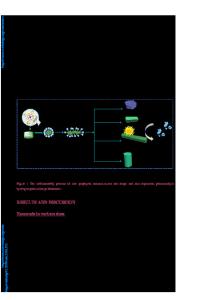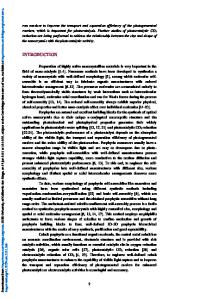Size- and shape-dependent photocatalysis of porphyrin nanocrystals
- PDF / 2,363,141 Bytes
- 6 Pages / 585 x 783 pts Page_size
- 115 Downloads / 320 Views
troduction Visible light-driven catalytic reactions are an important way to solve environmental pollution and the energy crisis. In the photocatalytic process, light-harvesting and subsequent photogenerated charge-carrier transfers are the key processes to achieve efficient solar-energy conversion for a photocatalyst.1 The design and fabrication of π-conjugated (interatomic interaction leads to π electron rearrangement) molecules-based solid-state nanocrystals enable superior capability of visible light capture and exciton diffusion and have gained increasing attention for applications in electronics, photonics, light-energy conversion, and catalysis.2,3 To this end, porphyrins, or so-called “pigments of life,” have become attractive building blocks. Porphyrins have tunable and well understood π–π conjugated electronic structures and spectroscopic characteristics.4 The self-assembled porphyrin nanocrystals with the conjugated π structure are expected to exhibit more complicated absorption and emission spectra than those of the monomers.5–8 Selfassembly of porphyrins from molecular units into specific spatial arrangements facilitates their efficient working through a
delocalized electron network. This is vital for achieving photofunctions in photovoltaic systems.9 Many porphyrin nanocrystal structures, including flowers, rods, tubes, and spheres have been synthesized through noncovalent interactions.10–15 Due to their rapid photo-induced charge separation and relatively slow charge recombination, the delocalized conjugated π structures of porphyrin nanocrystals have been extensively studied in electron-transfer processes to improve the photocatalytic activity.16,17 These porphyrin nanocrystals with well-defined structures benefit significantly from the improved photostability and lightharvesting properties from the ordered arrangement of porphyrin molecules. Interestingly, these materials exhibit size- and shape-dependent photocatalytic properties. Porphyrin nanocrystals of various sizes and shapes have been prepared by controllable self-assembly, and their visible light catalytic properties have been well studied. This article summarizes recent research in the synthesis of porphyrin nanocrystals and the size and shape dependence of their photocatalytic performance. We discuss the intrinsic mechanisms of this dependency. Emphasis is placed on emerging strategies
Qi Li, Key Laboratory for Special Functional Materials of the Ministry of Education, National and Local Joint Engineering Research Center for High-Efficiency Display and Lighting Technology, School of Materials Science and Engineering, and Collaborative Innovation Center of Nano Functional Materials and Applications, Henan University, China; [email protected] Nana Zhao, Key Laboratory for Special Functional Materials of the Ministry of Education, National and Local Joint Engineering Research Center for High-Efficiency Display and Lighting Technology, School of Materials Science and Engineering, and Collaborative Innovation Center of Nano Functional Materia
Data Loading...










